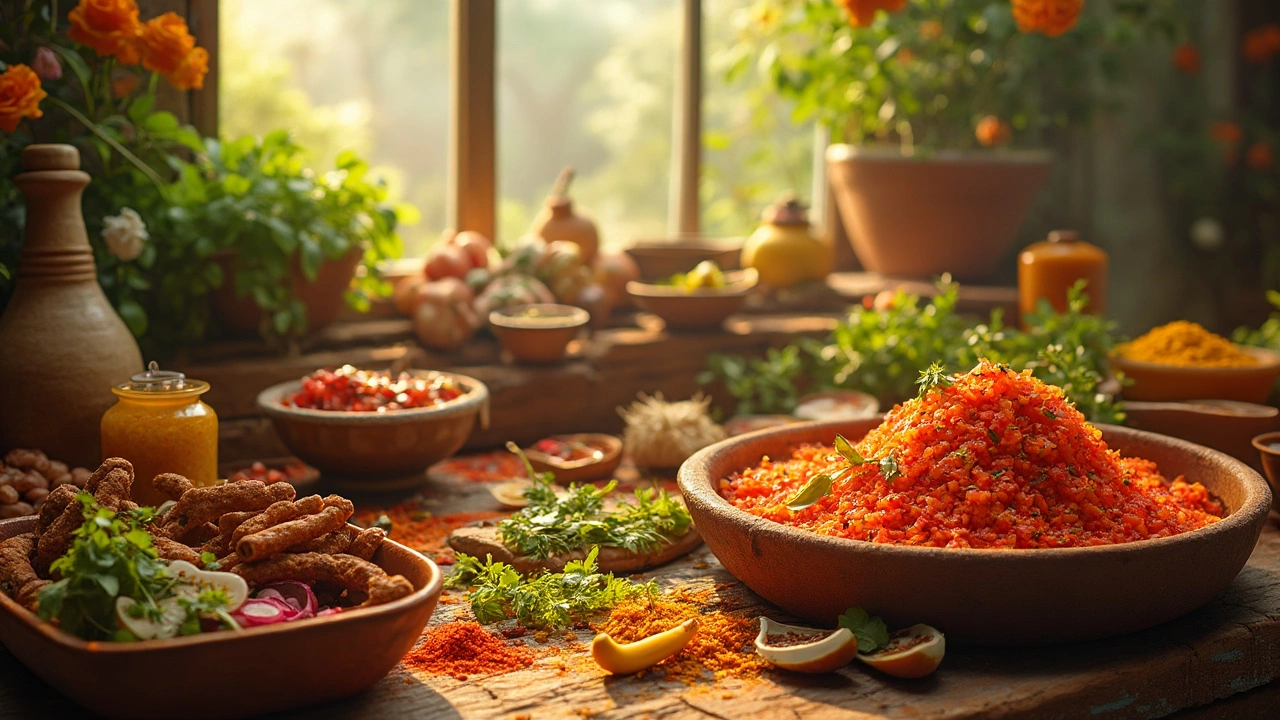Is Pickle Relish a Chutney?
 Mar, 29 2025
Mar, 29 2025
Have you ever found yourself wondering whether that tangy jar of pickle relish in your fridge qualifies as chutney? You’re not alone! They both bring a pop of flavor to the plate, yet they’re not exactly the same thing. Dive in with me as we unravel what makes each of these condiments special and when you might reach for one over the other.
Pickle relish is a staple at many BBQs and picnics, especially alongside hot dogs and burgers. It’s usually made from pickled cucumbers with a bit of sweetness and tanginess thrown in for good measure. On the other hand, chutney hails from Indian cuisine and varies widely, combining fruits, spices, and even some heat.
While both pickle relish and chutney aim to jazz up your meal, the ingredients and methods set them apart. Each offers its distinctive flavor punch and chance to experiment in the kitchen. Let’s break down how these two condiments differ and discover how you can make each one a kitchen hero in its own right.
- Understanding Pickle Relish
- The World of Chutneys
- Comparing Relish and Chutney
- Tips for Using Relish and Chutney
Understanding Pickle Relish
Alright, let's break down what makes pickle relish a fan favorite. Typically, this condiment is built on a base of finely chopped pickled cucumbers. You know, that sour and sweet combo we all love on a loaded hot dog? But there's more to it than just cucumbers.
Pickle relish gets its unique taste thanks to a mix of vinegar, sugar, and spices like mustard seed, garlic, and sometimes even a hint of dill or onion. The exact recipe might vary depending on cultural traditions or personal taste preferences. Still, sweet or dill, the relish is about balance — enough sweetness to offset the vinegar's sharpness but still bright enough to make your taste buds stand up and take notice.
Want to know a fun fact? Pickle relish has been jazzing up American dishes since at least the early 20th century. It's basically the love child of America’s pickle obsession and the need to liven up bland, everyday meals.
While making it at home isn't super common, it’s totally doable. All you need is some fresh cucumbers, vinegar, sugar, and spices. Give it a try if you want that homemade touch in your dishes. You can even jazz it up with a few extra ingredients for a twist, like adding hot peppers if you're into a spicy kick.
As a little guide, here’s a basic way to put together your own pickle relish:
- Start by chopping cucumbers and onions into small pieces.
- Add them to a pot with vinegar, sugar, and your choice of spices.
- Let it simmer to absorb all flavors — the longer, the better!
- Cool and store it in jars. Voila! Your homemade relish is ready to spice up any meal.
The next time you grab that jar of pickle relish, you’ll know exactly what makes it tick. Whether you're spooning it onto a hotdog or mixing it into potato salad, relish is there to take your food to flavor town.
The World of Chutneys
Chutney is like a culinary passport to the rich tapestry of Indian flavors. Traditionally, **chutney** has been a part of Indian cuisine for centuries, often accompanying meals that range from simple rice dishes to elaborate feasts. It's all about balancing sweetness, sourness, and spiciness, creating a real explosion of flavors.
So, what's in a typical **chutney**? Well, they’re incredibly versatile. You can whip up a chutney using fruits like mangoes, tomatoes, or even coconut. Then, spice it up with ginger, garlic, and chili, and don't forget the dash of vinegar or lemon juice for that signature tang.
In India, each region has its version, highlighting local produce and spices. For instance, you might find a mint chutney in the north, often paired with street food like samosas. Down south, coconut chutney usually joins the breakfast table with dosa and idli.
Unlike **pickle relish**, which mostly sticks to cucumbers, chutneys invite a wider range of ingredients. They can be smooth like a sauce or chunky, depending on the recipe. And the best part? There are no strict rules, so you can really make it your own.
If you're exploring these tasty waters for the first time, starting with a mango chutney might be a safe bet. Just blend ripe mangoes, add some sugar, vinegar, and spices, and let it simmer until it thickens. It’s a treat with everything from grilled meats to cheese and crackers.
- Key ingredients include fruits, spices, and a souring agent like vinegar or lemon juice.
- Preparation methods can vary, resulting in smooth or chunky textures.
- Regional variations reflect the diversity and abundance of local Indian produce.
So, next time you're looking at that jar of **pickle relish**, remember the **chutney** aisle where endless possibilities wait to jazz up your dishes!

Comparing Relish and Chutney
So, what’s the real scoop on pickle relish versus chutney? Even though they both aim to enhance your meals, their paths to your tastebuds are pretty different.
Let's start with what’s in them. Pickle relish usually centers around cucumbers. It's all about that crunch mixed with a blend of vinegar, sugar, and spices. Think of it as the zesty cousin to a cucumber pickle. The sweetness balances the zing, making it a BBQ essential.
Meanwhile, chutney plays in a different league. Originating from Indian cuisine, it’s a bigger mix of ingredients. Fruits like mango or coconut often take center stage, spiced up with chilies, garlic, ginger, and various spices. Imagine spicy sweet and everything in between. You might find chutneys with a smooth, sauce-like flow or those studded with chunks of fruit or vegetables.
Their culinary roles also differ. Relish tends to be a topping hero, brightening up hot dogs and sandwiches. Chutney, on the other hand, is more versatile. It’s a favorite accompaniment for Indian curries, a tangy spread on meats like chicken, or even a dip. You could say chutney is a globetrotter of sorts, making its way onto fusion platters worldwide.
Here's a quick snapshot of what sets them apart:
- Ingredients: Relish mainly features cucumber, while chutney is all about fruits and spices.
- Texture: Relish is often crunchy; chutney can range from chunky to smooth.
- Use in Dishes: Relish shines on grilled foods; chutney pairs with a wide array of dishes, especially curries.
With these differences laid out, understanding when to grab that jar of relish or chutney becomes much clearer. Embellish your dishes with these condiments and bring out their unique flavors!
Tips for Using Relish and Chutney
If you've got jars of pickle relish or chutney sitting on your shelf, it's time to put them to good use! Both of these flavorful condiments can really up your cooking game, so let’s explore some handy tips and tricks to incorporate them into your meals.
Firstly, when it comes to pickle relish, think beyond just slapping it on a hot dog. It's great for mixing into potato salad or even into a tuna or chicken salad for some added zing. You can also stir it into mayo to create a quick tartar sauce—perfect for fish dishes. Don’t be shy about adding a spoonful to a sandwich or wrap either. It’s a subtle way to make your lunchtime favorites taste not-so-ordinary.
Chutney, with its roots in Indian cuisine, has even more versatility. Try pairing it with cheese on a tasting board. The combination of sweet and spicy chutneys with sharp cheeses can turn a regular cheese platter into something special. You can even mix a dollop of chutney into your curry to add depth and a hint of sweetness. Spread it onto warm naan or flatbreads to elevate them from plain sides to interesting bites.
- Blend flavors: Don’t hold back from mixing different types of relish and chutney to find a new taste that you like. It’s all about experimenting!
- Marinades: Use chutneys as a base for marinades, particularly for meats. The sweet and tangy flavors can tenderize and flavor the meat wonderfully.
- Spice up dips: Stir relish into your dips for something different. It can bring a fresh twist to guacamole or salsa.
- Baking ingredient: Try using chutney as an ingredient in baking sweet breads or muffins. It keeps the baked goods moist and adds unexpected flavor.
Remember, the key to making the most of pickle relish and chutney is to get creative. Whether you’re looking to spice things up or just add some unexpected flavors to your meals, these condiments are your go-to kitchen buddies. Start experimenting and you might just find your new favorite dish!
